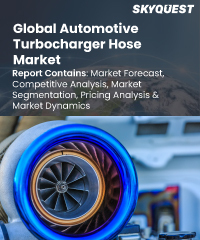
Report ID: SQMIG25A2139

Report ID:
SQMIG25A2139 |
Region:
Global |
Published Date: February, 2024
Pages:
157
|
Tables:
116 |
Figures:
77
Automotive Turbocharger Hose Market size was valued at USD 2.44 Billion in 2023 and is poised to grow from USD 2.59 Billion in 2024 to USD 4.16 Billion by 2032, growing at a CAGR of 6.1% during the forecast period (2025-2032).
The global automotive turbocharger hose market has been witnessing steady growth, driven primarily by the increasing demand for turbocharged vehicles across the automotive industry. Turbocharger hoses play a crucial role in turbocharged engines by supplying air to the turbocharger, which then compresses it before it enters the engine's combustion chamber.
This process enhances engine performance, increases fuel efficiency, and reduces emissions, making turbocharger hoses an integral component in modern automotive systems. One of the key factors contributing to the growth of the market is the rising stringency of emission regulations worldwide. Governments and regulatory bodies are imposing stricter emissions standards, prompting automakers to adopt turbocharging technology to meet these requirements while maintaining engine performance. This trend has led to a significant increase in the installation of turbochargers in both gasoline and diesel engines, thereby driving the demand for turbocharger hoses.
Moreover, technological advancements in turbocharger design and materials used in hose manufacturing have further propelled market growth. Manufacturers are increasingly focusing on developing lightweight and durable hoses capable of withstanding high temperatures and pressures generated in turbocharged engines. Additionally, the integration of advanced materials such as silicone and fluoroelastomers has enhanced the performance and longevity of turbocharger hoses, contributing to their widespread adoption.
However, the market is not without its challenges. Intense competition among manufacturers, price volatility of raw materials, and the complexity of turbocharger hose design and manufacturing processes pose significant hurdles for market players. Moreover, the emergence of alternative propulsion technologies such as electric vehicles (EVs) and hybrid vehicles could potentially disrupt the demand for traditional internal combustion engine components, including turbocharger hoses, in the long term.
Looking ahead, the global automotive turbocharger hose market is expected to continue its growth trajectory, driven by ongoing technological advancements, increasing vehicle production, and the implementation of stricter emissions regulations worldwide. Market players are likely to focus on product innovation, material advancements, and strategic collaborations to capitalize on emerging opportunities and address evolving customer demands in the automotive industry.
Our industry expert will work with you to provide you with customized data in a short amount of time.
REQUEST FREE CUSTOMIZATIONWant to customize this report? This report can be personalized according to your needs. Our analysts and industry experts will work directly with you to understand your requirements and provide you with customized data in a short amount of time. We offer $1000 worth of FREE customization at the time of purchase.

Report ID: SQMIG25A2139